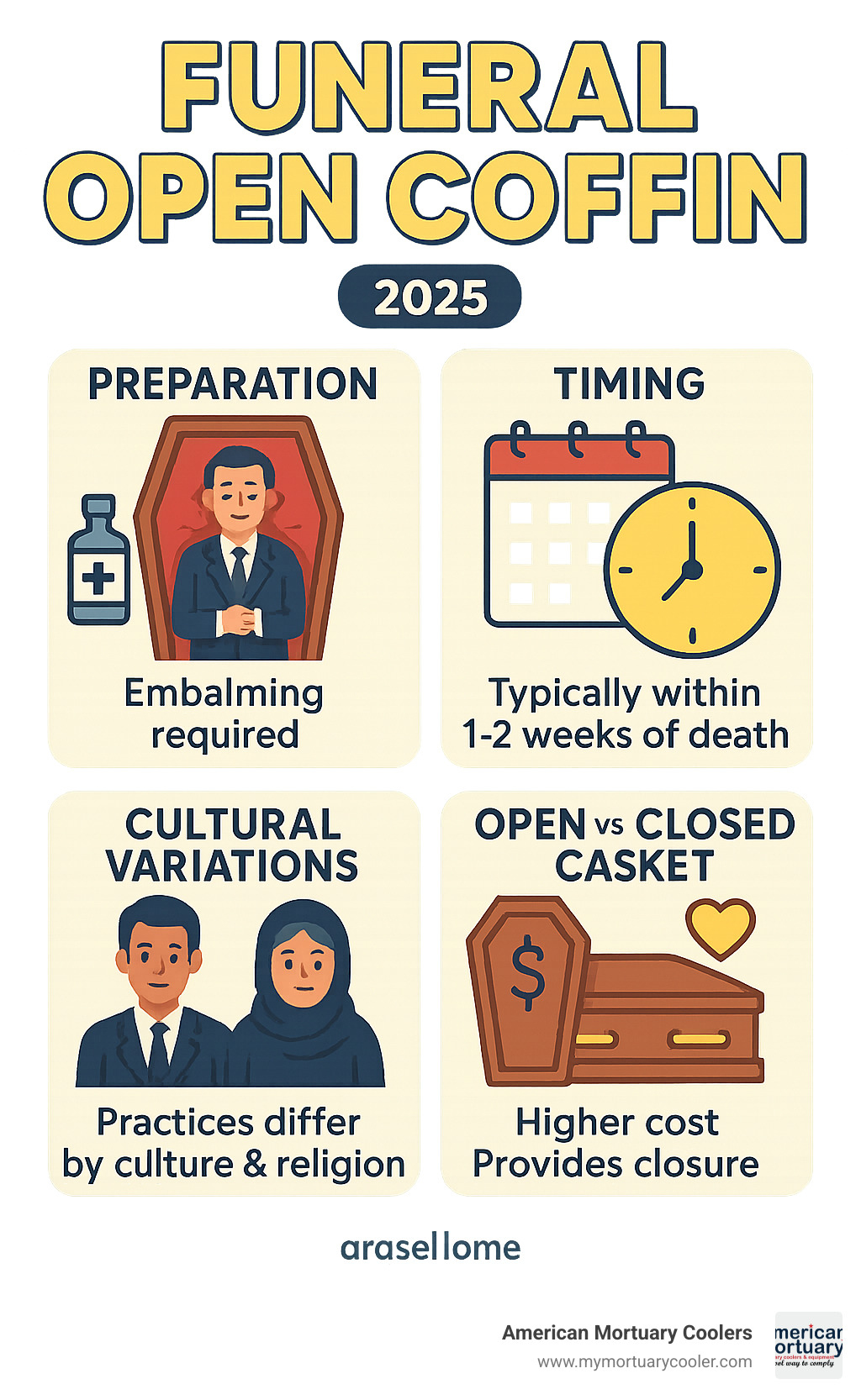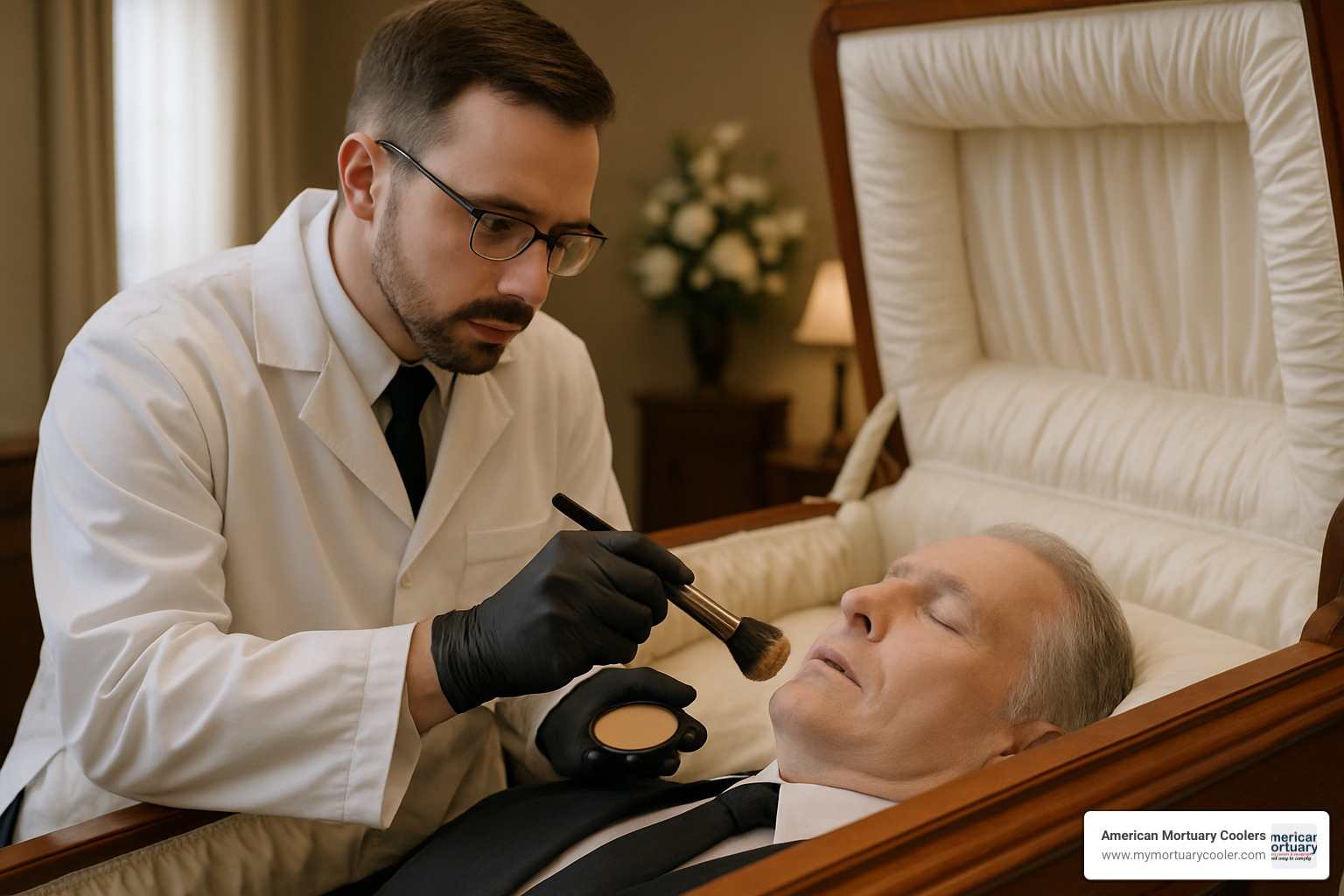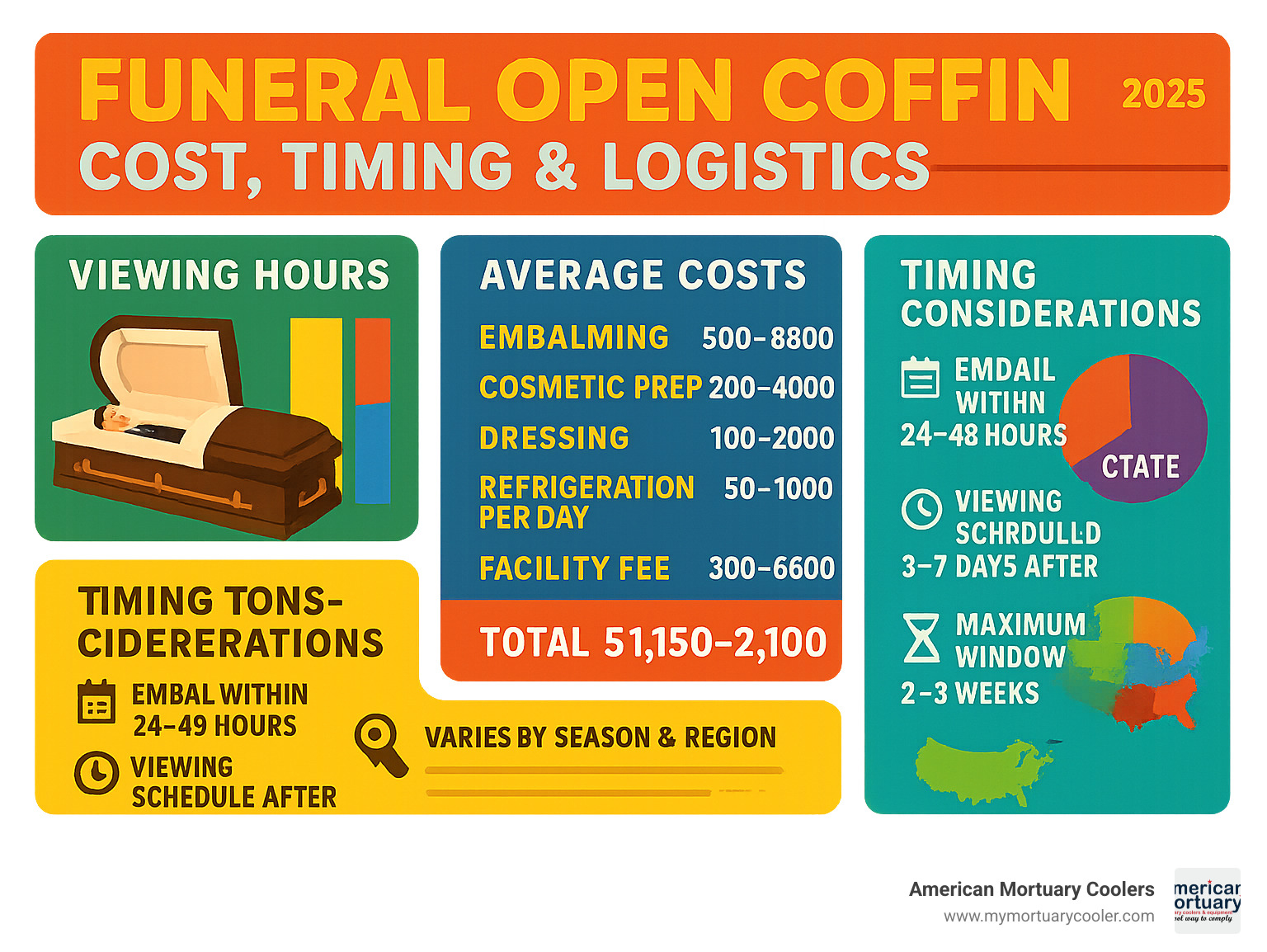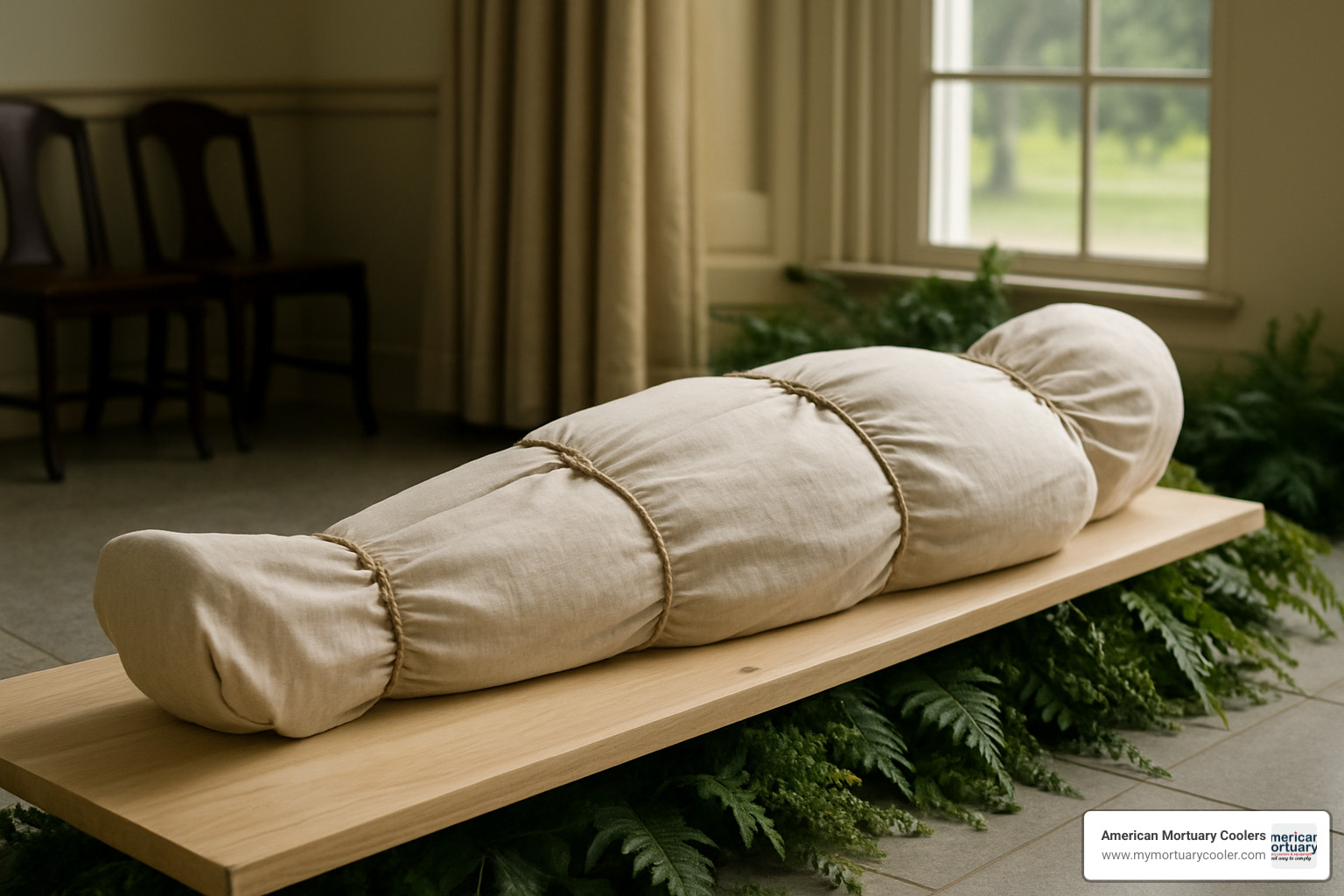Understanding the Sacred Tradition of Open Coffin Viewings
A funeral open coffin is a time-honored practice where the deceased's body is displayed in an open casket, allowing family and friends to pay their final respects and say goodbye. This tradition serves multiple purposes across cultures worldwide.
Key Facts About Open Coffin Funerals:
- Definition: A viewing where the top half of the casket remains open to display the deceased
- Purpose: Provides closure, confirms the reality of death, and allows final goodbyes
- Timing: Typically occurs within 1-2 weeks of death with proper embalming
- Global Practice: Common in the United States but varies significantly by culture and religion
- Preparation Required: Body must be embalmed, dressed, and cosmetically prepared
- Alternative: Closed casket services where the body remains unseen
Open coffin viewings have deep historical roots and remain prevalent in many faiths, though practices vary widely. Research shows that viewing the body after death helps family members accept the reality of loss, with very few participants regretting their decision to view their deceased loved one.
We are American Mortuary Coolers, a national-level mortuary cooler supplier with extensive experience helping funeral homes maintain proper preservation for funeral open coffin services across the United States. Our expertise in mortuary refrigeration equipment ensures funeral directors can provide families with dignified viewing opportunities when timing and preparation are critical factors.

Customs & Definitions of a Funeral Open Coffin
The tradition of viewing our deceased loved ones stretches back to humanity's earliest days. Today's funeral practices have evolved from these ancient customs, but the core purpose remains the same.
A viewing specifically refers to the time when people can see the prepared body before the funeral service begins. A visitation is broader—it's a gathering where people come to support the family, and it may or may not include seeing the deceased. The term wake originally meant keeping watch over the body through the night, but now it's often just another word for viewing.
The physical setup of a funeral open coffin typically involves what's called a half-couch casket. This means only the top half opens, showing the person's face, shoulders, and upper body—creating a peaceful, natural appearance.
Different regions have developed their own approaches over time. In the United States, open casket viewings remain the norm across most religious traditions. The United Kingdom has moved more toward closed caskets, though open caskets still appear for public figures or after tragic deaths. Ireland maintains strong traditions around open coffin reposal, while among New Zealand's Māori people, viewings at the local marae become community-wide events with ritual speeches and shared meals.
Scientific research on viewing practices shows these customs serve real psychological and social purposes that help communities process loss together.
What Is an Open Coffin Funeral?
An open coffin funeral centers around the prepared body of the deceased being displayed in a casket with the lid open, giving mourners the chance to see their loved one and say their personal goodbyes. This practice creates a powerful moment of visual confirmation that helps people understand the finality of death.
The funeral open coffin serves purposes that go far deeper than simply looking at the deceased. People can confirm the reality of death in a way that truly helps with grief processing, say personal goodbyes through quiet words or silent prayers, and leave personal items like letters or photos with their loved one.
This differs significantly from memorial services, which focus on memories and stories. The open coffin funeral keeps the physical presence of the deceased as the central element, making the loss feel real and final in a way that can actually be healing.
Open vs. Closed Coffin: Key Differences
Choosing between open and closed coffin services involves weighing several practical and emotional factors that affect both the family's experience and the logistics of the funeral.
Display and privacy represent the most obvious difference. Open coffins invite direct viewing and personal interaction, while closed coffins maintain privacy while still honoring the deceased's presence.
Preservation requirements create significant practical differences. Open coffins absolutely require embalming, while closed coffins offer more flexibility with refrigeration options.
Religious and cultural considerations often make the decision for families. Most Christian denominations readily accept open coffin traditions, while Judaism and Islam typically require closed coffin services.
| Aspect | Open Coffin | Closed Coffin |
|---|---|---|
| Average Cost | $2,000-4,000 additional | $500-1,500 additional |
| Timing Flexibility | Limited (1-2 weeks max) | More flexible |
| Emotional Impact | High closure potential | Preserves peaceful memories |
| Preparation Time | 3-7 days traditional | Minimal preparation needed |
| Religious Acceptance | Most Christian denominations | Universal acceptance |
At American Mortuary Coolers, we understand that timing can be everything when families are planning funeral open coffin services. Our custom mortuary coolers help funeral directors maintain proper preservation when scheduling becomes complicated.
Why Families Choose—or Avoid—an Open Coffin
When a loved one passes away, families face one of the most difficult decisions during an already overwhelming time: whether to hold a funeral open coffin service. This choice touches the very heart of how we say goodbye and process our grief.
Many families gravitate toward open coffin viewings because they offer something precious—closure. There's something deeply human about needing to see our loved one one final time. The peaceful appearance of someone we care about, carefully prepared and at rest, can transform our last memory from one of illness or trauma to one of dignity and peace.
This becomes especially meaningful when death strikes suddenly or when distant relatives need to travel from far away. The funeral open coffin viewing becomes that missed opportunity—a chance to speak those final words or simply hold their hand one last time.
But not every family chooses this path. Sometimes traumatic death or extended illness changes the body in ways that make viewing distressing rather than comforting. Environmental concerns also influence modern decisions, with families pursuing green burial often avoiding the embalming chemicals required for open coffin viewing.
Emotional & Psychological Effects of Viewing
The research on viewing deceased loved ones reveals something remarkable about human psychology. Even when the circumstances are difficult, most people don't regret choosing to see their family member or friend one final time.
A groundbreaking study examined families who viewed loved ones after traumatic deaths. While many participants described feeling shocked initially, the researchers found that very few regretted their decision to view. Instead, the viewing helped "cement the reality of death" in a way that supported healthy grief processing.
Scientific research on traumatic death consistently shows that accepting the reality of loss is crucial for moving through grief. When we avoid that reality, we can get stuck in complicated grief—a condition where healing stalls because part of us still can't believe our loved one is truly gone.
Cultural & Religious Influences
Your family's faith and cultural background often provide guidance about funeral open coffin decisions, though practices vary more than many people realize.
Christianity broadly accepts open coffin traditions. Catholic families often incorporate viewing into visitation hours before the funeral mass, while Protestant services may include viewing as part of the formal ceremony.
Judaism and Islam take a different approach entirely. Both faiths require prompt burial—typically within 24 hours—and closed coffin services. The focus shifts from viewing the body to supporting the family through prayer and community presence.
Hindu and Buddhist traditions vary significantly by region and family custom, with some communities including viewing while others focus on ritual preparations and spiritual ceremonies.
Practical Factors: Condition, Timing & Budget
Beyond emotions and beliefs, practical realities shape every funeral open coffin decision.
Embalming becomes essential for open coffin viewing. This process involves arterial injection of preservative chemicals to maintain natural appearance and prevent decomposition odors.
Timing creates pressure that many families don't anticipate. Bodies can typically be viewed for one to two weeks after death with standard embalming, though advanced preservation techniques can extend this to three weeks maximum.
Our expertise at American Mortuary Coolers becomes crucial here. Our custom mortuary coolers help funeral homes maintain optimal preservation temperatures, extending viewing windows when families need extra time for travel or preparation.
Budget considerations add another layer of complexity. Open coffin services typically cost $2,000 to $4,000 more than closed coffin alternatives, including embalming fees, cosmetic preparation, and extended facility use.
Behind the Scenes: Preparing the Body for an Open Coffin
When families choose a funeral open coffin service, skilled professionals work behind the scenes to create a peaceful, dignified presentation. This careful preparation process requires both technical expertise and artistic sensitivity to honor the deceased while providing comfort to grieving loved ones.

The preparation unfolds through carefully orchestrated steps. Initial care involves gentle washing and positioning, followed by feature setting where eyes and mouth are closed to create a serene expression. The embalming process uses arterial injection and cavity treatment to preserve the body's appearance.
Restorative work addresses any injuries, while cosmetic application restores natural coloring. Hair styling and dressing transform the clinical preparation into a personal presentation, and final positioning in the casket includes any meaningful personal items.
Modern technology has revolutionized some aspects of this practice. Funeral homes in China now use 3D printing for facial reconstruction when time is critical, producing facial molds in just half a day compared to the traditional 3-7 days.
Embalming, Dressing & Makeup Essentials
The foundation of any successful funeral open coffin presentation lies in professional embalming. This preservation process involves replacing the body's blood with specially formulated chemicals through arterial injection.
Color correction becomes crucial in mortuary cosmetology. Embalming chemicals can create unnatural yellow tones, so skilled professionals apply carefully chosen makeup to restore the warm, natural coloring that families remember.
Recent photographs of the deceased become invaluable guides during this process, helping mortuary artists recreate the person's everyday appearance, from their preferred makeup style to their typical hairstyle.
More info about casket platforms can help funeral directors choose appropriate presentation options for different services.
Personalization & Keepsakes in the Coffin
Personal touches transform a standard viewing into a meaningful celebration of someone's unique life. Military veterans frequently wear dress uniforms with service medals, while religious items like prayer cards or rosaries provide spiritual comfort.
Personal letters from family members offer one final opportunity for communication. Hobby-related items celebrate the passions that brought joy during life—a fisherman might be surrounded by favorite lures, or a musician by sheet music from beloved songs.
Family photographs create connections across generations, while meaningful jewelry maintains the bonds that death cannot break. These personalizations honor the deceased's memory while providing deep comfort to mourners.
More info about funeral coffin spray offers guidance on selecting floral arrangements that complement personal items.
Etiquette & Guest Guidance at a Funeral Open Coffin
Attending a funeral open coffin service requires understanding specific etiquette guidelines that show respect for the deceased and support for the grieving family.
Basic Etiquette Guidelines:
- Approach the casket quietly and respectfully
- Maintain a neutral or sympathetic facial expression
- Avoid commenting on the deceased's appearance
- Keep conversations brief and focused on condolences
- Allow immediate family private time when requested
- Follow the funeral director's guidance
Photography and Recording: Never take photos or videos of the deceased or casket area. This violates privacy and shows profound disrespect.
Physical Contact: Light touching of the deceased's hand or a gentle kiss on the forehead is generally acceptable, but avoid extensive handling. The embalmed body will feel cold and firm.
Adult Attendees: Respectful Behaviour
Adult mourners should approach funeral open coffin services with quiet dignity and emotional composure. While grief is natural, hysterical displays can distract from the service's purpose.
Appropriate Actions:
- Speak in hushed tones or remain silent
- Offer brief condolences to family members
- Share positive memories when appropriate
- Provide emotional support to other mourners
- Respect cultural or religious customs
Inappropriate Behaviors:
- Making comments about the deceased's appearance
- Taking photos or selfies
- Using mobile phones during viewing
- Expressing shock or disgust
Preparing Children & Sensitive Guests for Viewing
Children require special preparation for funeral open coffin services, as the experience can be confusing without proper context.
Preparing Children:
- Explain that the person looks like they're sleeping but won't wake up
- Describe how the body will feel cold and different
- Allow children to choose their viewing distance and duration
- Provide a trusted adult companion
- Offer alternative ways to say goodbye if viewing becomes distressing
For Sensitive Adults:
- Inform guests in advance about open coffin viewing
- Suggest seating options that allow distance from the casket
- Provide information about stepping outside if needed
- Offer alternative memorial activities
More info about funeral receptions can help families plan comprehensive support for all attendees.
Cost, Timing & Logistics at a Glance
Typical Viewing Hours:
- Private family viewing: 1-2 hours before public viewing
- Public visitation: 2-6 hours depending on expected attendance
- Service viewing: 15-30 minutes before closing the casket
Average U.S. Costs:
- Basic embalming: $500-800
- Cosmetic preparation: $200-400
- Dressing and positioning: $100-200
- Extended refrigeration: $50-100 per day
- Facility use for viewing: $300-600
- Total additional cost: $1,150-2,100
Timing Considerations:
- Embalming should occur within 24-48 hours of death
- Viewing typically scheduled 3-7 days after death
- Maximum viewing window: 2-3 weeks with proper preservation
We at American Mortuary Coolers support funeral homes with reliable refrigeration equipment that extends preparation time and maintains optimal conditions for open coffin services.

Alternatives & Special Situations to the Funeral Open Coffin
Sometimes a funeral open coffin service isn't the right choice for a family. Whether due to circumstances beyond their control, personal beliefs, or practical concerns, there are many meaningful ways to say goodbye that don't involve viewing the body.

Families can choose closed coffin services where the casket remains sealed, memorial services that celebrate life without the body present, or cremation services followed by gatherings around the urn. The COVID-19 pandemic taught us about virtual services, where families livestream ceremonies for loved ones who can't travel.
Body donation for medical research creates another situation where traditional viewing isn't possible. These generous families often find great meaning in memorial services that focus on their loved one's final gift to science.
When an Open Coffin Is Not Recommended
There are times when even skilled funeral directors recommend against open coffin viewing. Severe physical trauma from accidents can make viewing inappropriate, even with advanced reconstruction techniques.
Advanced decomposition presents another challenge. When someone isn't found for days or weeks, embalming may not restore an appearance suitable for viewing.
Infectious disease protocols became a harsh reality during the pandemic. Certain illnesses require special handling that makes open coffin viewing unsafe.
Cultural and religious beliefs also play a role. Some faiths explicitly prohibit body viewing, requiring immediate burial or specific handling.
Sometimes the family's emotional well-being is the deciding factor. When viewing might traumatize children or vulnerable adults, closed coffin services offer a gentler path through grief.
Creative Farewell Alternatives
Families who can't or don't want traditional funeral open coffin services have found beautiful alternatives that honor their loved ones meaningfully.
Shroud burial services appeal to environmentally conscious families. The body is wrapped in biodegradable cloth, often with a brief viewing before the wrapping ceremony.
Photo memorial displays can be incredibly powerful. Instead of viewing the body, families create comprehensive presentations of their loved one's life through pictures, videos, and personal items.
Urn-centered services work beautifully when cremation happens before the memorial. Families often create stunning displays around the urn, surrounding it with flowers, photos, and meaningful items.
Living memorials focus on ongoing legacy rather than a single goodbye moment. Planting trees, creating scholarship funds, or establishing charitable foundations creates lasting impact.
More info about shroud funerals can help families explore these environmentally conscious options.
The key is finding what feels right for your family. There's no universal correct way to say goodbye, and the most meaningful services often combine traditional elements with personal touches.
Frequently Asked Questions About Open Coffin Funerals
When families consider a funeral open coffin service, they often have practical questions about expectations, timing, and personal choices.
Does everyone have to view the body?
No one is ever required to view the deceased at a funeral open coffin service. This choice remains entirely personal for each attendee.
Guests have several respectful options during viewing periods. They can approach the casket for a personal goodbye, remain seated at a comfortable distance, or step outside if the experience feels overwhelming.
Children deserve special consideration in these situations. Parents should never pressure children to view the deceased, instead offering age-appropriate explanations and allowing them to choose their own comfort level.
How long after death can you still have an open coffin?
The timeline for funeral open coffin services depends on preservation methods and environmental factors, but families generally have more flexibility than they might expect.
Professional embalming creates the foundation for extended viewing periods. With proper embalming techniques, bodies can be viewed comfortably for one to two weeks after death. Advanced preservation methods can extend this window up to three weeks.
Refrigeration support significantly extends viewing options. We at American Mortuary Coolers provide specialized equipment that helps funeral homes maintain optimal preservation temperatures, giving families additional time when they need to coordinate travel or manage complex arrangements.
Can personal items stay in the coffin during burial?
Most personal items can absolutely remain with the deceased during burial, creating meaningful connections that comfort grieving families.
Commonly accepted items include letters and cards from family members, small jewelry pieces, religious items such as prayer cards or rosaries, and photographs of meaningful memories. Military veterans often wear service medals and ribbons.
Some practical restrictions may apply based on cemetery policies or environmental considerations. Valuable jewelry might be removed for security reasons, while items containing batteries or chemicals could pose hazardous material concerns.
Families should discuss their wishes openly with funeral directors, who can provide guidance on appropriate items and explain any local restrictions.
Conclusion
Choosing whether to hold a funeral open coffin service is one of the most personal decisions families make during their darkest hours. There's no universal right answer—only what feels right for your family and honors your loved one's memory.
Throughout this guide, we've walked through the sacred traditions that span cultures and centuries, the practical realities of preparation and timing, and the deep emotional considerations that make each family's choice unique. Some find profound comfort in that final visual goodbye, while others prefer to remember their loved one as they lived.
What matters most is creating a farewell that brings peace to those left behind. Whether that's a traditional open casket viewing surrounded by flowers and personal mementos, a quiet closed casket service with family prayers, or an entirely different memorial celebration, the "right" choice is whatever helps your family begin to heal.
The practical elements—embalming timelines, cultural traditions, budget considerations—are important, but they're tools to serve your family's needs, not rules that should add stress during an already difficult time. Experienced funeral directors understand this balance and can guide you through options that work within your circumstances.
We at American Mortuary Coolers have spent years supporting funeral homes across all 48 contiguous states with the specialized refrigeration equipment that makes funeral open coffin services possible when timing becomes critical. From our Tennessee base, we've seen how proper preservation gives families the gift of time—time to gather, time to prepare, and time to say goodbye properly.
But we've also learned that the most beautiful funeral isn't measured by perfect preparation or flawless logistics. It's measured by whether it brought comfort to the people who needed it most.
Trust your instincts, lean on your funeral director's expertise, and remember that honoring your loved one starts with honoring your family's needs. Whether you choose viewing or memorial, traditional or alternative, elaborate or simple, the love behind your decision is what makes it meaningful.
More info about showroom caskets & viewing options can provide additional guidance as you explore what feels right for your family's unique situation.
